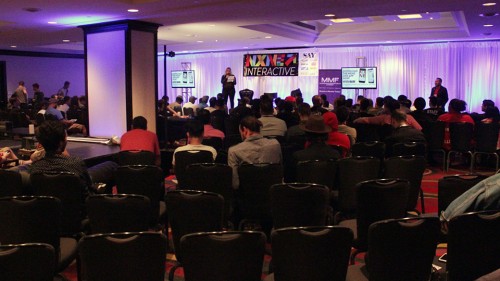When a music festival descends on a town, the excitement is palpable. The chance to see a wide variety of artists crammed into a few days is enticing for music lovers and every arm of the business shifts into high gear. However there is another not as well attended aspect of most music festivals: the conference. Conferences are a long held secret of the industry. They are an opportunity for artists, producers, managers, publicists and anyone with a vested interest in the nature of the music business to expand their clientele, increase their knowledge and rub elbows with the big wigs. One look at the line up of presenters and it’s easy to understand why these keynotes, panel discussions and presentations are something that shouldn’t be missed.
Navigating the conference is reminiscent of taking a stroll through a city zoo. The booths are organized in neat rows with banners providing info on the exotic fauna. Entering any of the meeting rooms is akin to entering a specially built pavilion. The stage serves as makeshift enclosures where rare and exotic presidents and CEOs are on display for the common people. It can be crowded, loud and even messy, but those who take the time to take in the sights will see their catalogue of music industry predator and prey expanded for the better.
One of the major prohibitive factors of attending the conference is the large price tag. All-access passes can run from a few hundred dollars to well over a thousand. Generally, organizers offer different tiers of admission to help better craft a participant’s itinerary. Here lies a certain element of risk. For anyone who is going to invest the necessary funds to attend, it’s a good idea to come up with an agenda as early as possible. Many of the sessions run concurrently. Hoping to catch a specific event? Plan for it.
Acronyms like A.T.S. and A.T.V. require a certain level of familiarity to translate, but they highlight the often-overlooked hard data that can attract investors. Even though many of the conversations revolve around marketing with millions of dollars in budgets, the same key principles apply when working on smaller scale levels.
The early morning’s keynotes are generally reserved for suits. You’re unlikely to see a multitude of ravenous media hounds or starving artists during those hours. There are plenty of opportunities for unique engagements, but without the glamour of the celebrities, the revelers are generally absent. However, these early day sessions are where you get a glance at what the insiders see. The panelists assembled hold the highest offices within their respective corporations and this is an opportunity to understand what parts of the business they pay attention to. These are the CEOs and directors that sign off on the cheques and understand the ebb and flow of the market. Some of the conversation can be heavy at times. Acronyms like A.T.S. and A.T.V. require a certain level of familiarity to translate, but they highlight the often-overlooked hard data that can attract investors. Even though many of the conversations revolve around marketing with millions of dollars in budgets, the same key principles apply when working on smaller scale levels.
Beyond the boring business chatter there is an element of inspiration intertwined that can’t be understated. Hearing the controversial Jon McAfee talk over Skype about privacy and the wild west that is the Internet at Canadian Music Week 2014 was a once in a lifetime experience. McAfee had to be coy about his whereabouts after allegedly surviving an attempt on his life, but took time to highlight his new completely encrypted messaging service Chadder. AOL’s digital prophet David Shing had another well-attended session. His rapid-fire delivery is well known throughout the business and his “Your Brand’s Content Only Matters in Context” keynote did not disappoint. It’s these types of high-powered presentations that not only inform, but also excite attendees about the possibilities of their brand. Shingy, as he’s known in the Twitterverse, is somewhat of a rock star in executive circles. It’s a rare opportunity to see him “perform” one of his prophetic presentations even if you don’t earn a six-figure salary.
What if you’re not an executive? Do the conferences hold any value to an artist or producer? Absolutely. In fact many of the activities are designed around helping artists see what it takes to bring their art to the next level. There are opportunities to try to swing a few precious moments to pick the brain of the exec of your choice. Even hanging out in and around the venue can yield a variety of connections. You might see a starving artist belt out a tune in the middle of the hotel lobby to impress a freshly made connection or managers handing out newly pressed cards looking for the next big thing.
One of the more interesting phenomena you can find on the floor is sometimes referred to as a house of cards. On most tables that aren’t dedicated to water dispensers or specific activities you’ll find stacks of business cards, flyers and brochures relating to any number of music business related services.
Outside of the dimly lit keynote rooms you’re likely to find a treasure trove of contacts and products. Sennheiser used CMW this year to demo its $1000 IE 800 ear buds. Designed for mix engineers the buds are laced with space age material and at that astronomical price this demo could be your only chance to experience audio exuberance. Of course there are more practical services available too. Landr, “an instant and intelligent mastering service” by MixGenius is in fact genius. The website allows users to upload an unfinished audio mix and get a mastered mp3 emailed to them within minutes. The algorithm-based service does a decent job and can be a budget blessing for independent musicians. Such a highly specialized venture doesn’t have many places to target its audience it appears. “A tradeshow in Canada? There aren’t much choices for potential partners,” says Franck Nasso, Director of Channel Partnerships at MixGenius. “I see a lot of musicians that really love [Landr] and a lot of music studios [as well]. I’ve met different magazines to partner with, people like FACTOR. So it’s also a networking opportunity for us.”
There are a ton of other small perks littered throughout the conference floor. One of the more interesting phenomena you can find on the floor is sometimes referred to as a house of cards. On most tables that aren’t dedicated to water dispensers or specific activities you’ll find stacks of business cards, flyers and brochures relating to any number of music business related services. Anything from samples of custom promotional items to contacts for lawyers could be buried within the mountain and taking a few minutes to peruse through may net a substantial find.
Help is never far away. The smiling volunteers can usually direct you to what you’re looking for. However, don’t expect them to be well versed in industry speak. They can’t arrange interviews and are usually on a strict command not to engage attendees or media beyond the scope of giving directions. Security can be even curter. If they catch a wandering eye they’ll give a quick nod, but if a person’s attendee badge is obscured they’ll stop him/her almost every time.
While the direct line to the gatekeepers is established, the conference is not about sitting back and being taught a lesson. It’s about having a chance to cut through the red tape and possibly make that connection that will make it all worthwhile.
It’s important to take time to take it all in. One of the great things about such a tightly monitored event is that almost everyone has their name, company and position tattooed to a dangling lanyard. This makes it easy to identify a target of interest and start up a conversation. Be ready. These encounters can be brief and anyone who is not prepared runs the risk of their card ending up in a pile of discarded ones picked up that day.
There is no cookie cutter formula for you to follow to success. The marketing gods will not descend from upon the heavens to deliver the secret of recording a platinum record. Still, attending a conference can prove helpful when it comes to working toward that goal. While the direct line to the gatekeepers is established, the conference is not about sitting back and being taught a lesson. It’s about having a chance to cut through the red tape and possibly make that connection that will make it all worthwhile.
Words By. Sean Watson + Photos By. Adrian McKenzie




Comments are closed.